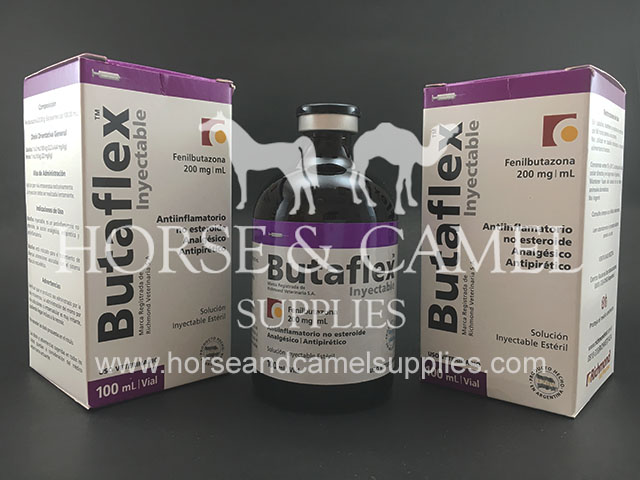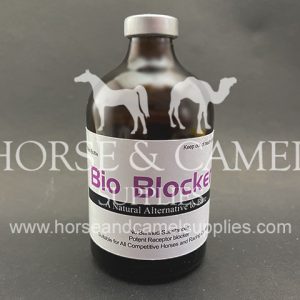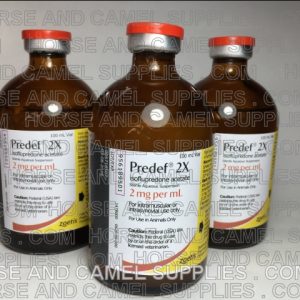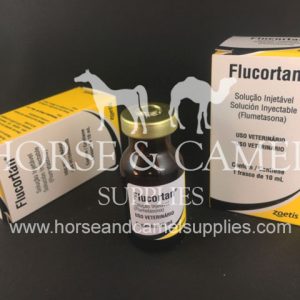Description
Treatment duration: The injection should be performed slowly by EV exclusively and be limited to only 5 consecutive days
Use restrictions
On horses, maintain a withdrawal period of 96 hours before the race.
Do not use on horses intended for human consumption.
Bioavailability
After its administration, the drug distributes through the body, with higher concentration in liver, heart, kidney and lungs. Plasma protein binding in 99%.
Phenylbutazone may displace other drugs that bind with plasma protein such as warfarin, in a way that may appear acute bleeding, since the pharmacological agents are therapeutically inert when they are bound to proteins, while the displacement of this union releases the drug to diffuse to its active place, being free and expose to metabolism and excretion.
Serum half-life on the horse has ranges of 3.5 to 6 hs, and on the dogs of 2.5 to 6 hs.; just as aspirin is dose dependent. However, therapeutic efficacy can reach more than 24hs, probably because of the irreversible ligation of phenylbutazone with cyclooxygenase.
In horses and other species, phenylbutazone is almost completely methabolized, first to oxyphenbutazone (active) and to gamma hydroxyphenylbutazone
Oxyphenbutazone has been detected in horse urine 48 hours after single dose. On the dog, oxyphenbutazone persist in urine for at least 48 hs after one oral dose of 8.9 mg/kg, not being detected in urine samples of 72 hs.
The unchanged drug (phenylbutazone) is not detected in dog’s urine samples of 36 hs. Both, phenylbutazone and oxyphenbutazone, cross the placenta and are excreted through milk.
Because phenylbutazone is a weak acid, it is generally suspected that this drug could be excreted more quickly in alkaline urine, while in acid urine excretion would be slower and prolonged.
Apparently, phenylbutazone major pharmacologic activity is induced after active metabolite formation, oxyphenbutazone.
Oxyphenbutazone, has essentially pharmacological effects, therapeutic uses, and toxicological effects similar to those of the phenylbutazone.
Contraindications and limits of use
- Do not apply in animals hypersensitive to the principle active.
- Do not apply in animals with preexistent hematological alterations, or gastrointestinal ulcers.
- It’s contraindicated in animals with liver, kidney or heart failure.
- It has not been establish safety during pregnancy, however, it can be use when therapeutic benefits overcome risks.
- It may cause gastrointestinal effects (dyspepsia, ulcers, diarrhea, anorexia), decreased renal blood flow and blood dyscrasias.
- Use with caution in ponies, because they are more susceptible to adverse effects.
- Phenylbutazone and its active metabolite, oxyphenbutazone can displace other drugs and thus affect seric levels and duration of oral anticoagulants, other anti-inflammatory drugs and sulfonamides.
- Phenylbutazone increases the penicillin G or lithium half life and antagonize furosemide. May interfere with the thyroid function tests by competition with thyroxine at protein binding sites.
Precautions and Warnings
- Verify that the product inviolability system and its storage conditions prior to use are adequate, as well as that it has not expired in reference to the expiration date expressed in the label.
- Verify exclusively intravenous route administration. The subcutaneous or intramuscular route of Butaflex is very irritative, may cause necrosis.
- Do not exceed the proposed dose.
- Intravenous administration must be done slowly.
- Do not eat. Keep out of reach of children and domestic animals.
- The doses and frequencies are at the discretion of the acting veterinarian.
- Store between 15 and 30°C, protected from direct light, in dry and hygienic place.
- Always consult your veterinarian.
Protect the environment
Ready to use sterile injectable solution






Reviews
There are no reviews yet.